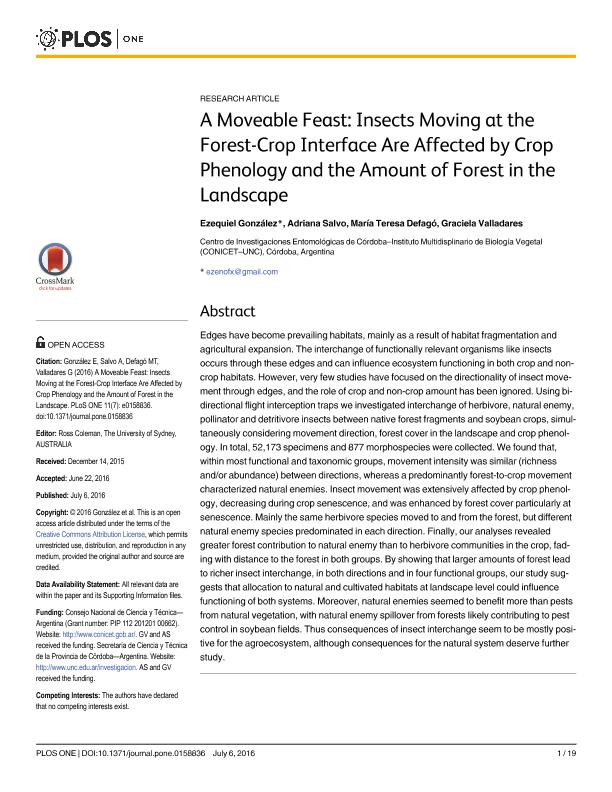Mostrar el registro sencillo del ítem
dc.contributor.author
González, Ezequiel

dc.contributor.author
Salvo, Silvia Adriana

dc.contributor.author
Defagó, María Teresa

dc.contributor.author
Valladares, Graciela Rosa

dc.date.available
2017-06-08T15:29:52Z
dc.date.issued
2016-06
dc.identifier.citation
González, Ezequiel; Salvo, Silvia Adriana; Defagó, María Teresa; Valladares, Graciela Rosa; A moveable feast: insects moving at the forest-crop interface are affected by crop phenology and the amount of forest in the landscape; Public Library Of Science; Plos One; 11; 7; 6-2016; 1-19; 0158836
dc.identifier.issn
1932-6203
dc.identifier.uri
http://hdl.handle.net/11336/17767
dc.description.abstract
Edges have become prevailing habitats, mainly as a result of habitat fragmentation and agricultural expansion. The interchange of functionally relevant organisms like insects occurs through these edges and can influence ecosystem functioning in both crop and non-crop habitats. However, very few studies have focused on the directionality of insect movement through edges,and the role of crop and non-crop amount has been ignored. Using bi-directional flight interception traps we investigated interchange of herbivore, natural enemy, pollinator and detritivore insects between native forest fragments and soybean crops, simultaneously considering movement direction, forest cover in the landscape and crop phenology. In total, 52,173 specimens and 877 morphospecies were collected. We found that, within most functional and taxonomic groups, movement intensity was similar (richness and/or abundance) between directions, whereas a predominantly forest-to- crop movement characterized natural enemies. Insect movement was extensively affected by crop phenology, decreasing during crop senescence, and was enhanced by forest cover particularly at senescence. Mainly the same herbivore species moved to and from the forest, but different natural enemy species predominated in each direction. Finally, our analyses revealed greater forest contribution to natural enemy than to herbivore communities in the crop, fading with distance to the forest in both groups. By showing that larger amounts of forest lead to richer insect interchange, in both directions and in four functional groups, our study suggests that allocation to natural and cultivated habitats at landscape level could influence functioning of both systems. Moreover, natural enemies seemedto benefit more than pests from natural vegetation, with natural enemy spillover from forests likely contributing to pest control in soybean fields. Thus consequences of insect interchange seem to be mostly positive for the agroecosystem, although consequences for the natural system deserve further study.
dc.format
application/pdf
dc.language.iso
eng
dc.publisher
Public Library Of Science

dc.rights
info:eu-repo/semantics/openAccess
dc.rights.uri
https://creativecommons.org/licenses/by-nc-sa/2.5/ar/
dc.subject
Insect Movement
dc.subject
Soybean
dc.subject
Chaco Serrano Forest
dc.subject
Forest Cover
dc.subject
Crop Phenology
dc.subject
Movement Direction
dc.subject
Functional Groups
dc.subject.classification
Conservación de la Biodiversidad

dc.subject.classification
Ciencias Biológicas

dc.subject.classification
CIENCIAS NATURALES Y EXACTAS

dc.subject.classification
Ecología

dc.subject.classification
Ciencias Biológicas

dc.subject.classification
CIENCIAS NATURALES Y EXACTAS

dc.subject.classification
Otras Ciencias Agrícolas

dc.subject.classification
Otras Ciencias Agrícolas

dc.subject.classification
CIENCIAS AGRÍCOLAS

dc.title
A moveable feast: insects moving at the forest-crop interface are affected by crop phenology and the amount of forest in the landscape
dc.type
info:eu-repo/semantics/article
dc.type
info:ar-repo/semantics/artículo
dc.type
info:eu-repo/semantics/publishedVersion
dc.date.updated
2017-06-06T14:42:46Z
dc.journal.volume
11
dc.journal.number
7
dc.journal.pagination
1-19; 0158836
dc.journal.pais
Estados Unidos

dc.journal.ciudad
San Francisco
dc.description.fil
Fil: González, Ezequiel. Consejo Nacional de Investigaciones Científicas y Técnicas. Centro Científico Tecnológico Conicet - Córdoba. Instituto Multidisciplinario de Biología Vegetal. Universidad Nacional de Córdoba. Facultad de Ciencias Exactas Físicas y Naturales. Instituto Multidisciplinario de Biología Vegetal; Argentina. Universidad Nacional de Córdoba. Facultad de Ciencias Exactas, Físicas y Naturales. Centro de Investigaciones Entomológicas de Córdoba; Argentina
dc.description.fil
Fil: Salvo, Silvia Adriana. Consejo Nacional de Investigaciones Científicas y Técnicas. Centro Científico Tecnológico Conicet - Córdoba. Instituto Multidisciplinario de Biología Vegetal. Universidad Nacional de Córdoba. Facultad de Ciencias Exactas Físicas y Naturales. Instituto Multidisciplinario de Biología Vegetal; Argentina. Universidad Nacional de Córdoba. Facultad de Ciencias Exactas, Físicas y Naturales. Centro de Investigaciones Entomológicas de Córdoba; Argentina
dc.description.fil
Fil: Defagó, María Teresa. Consejo Nacional de Investigaciones Científicas y Técnicas. Centro Científico Tecnológico Conicet - Córdoba. Instituto Multidisciplinario de Biología Vegetal. Universidad Nacional de Córdoba. Facultad de Ciencias Exactas Físicas y Naturales. Instituto Multidisciplinario de Biología Vegetal; Argentina. Universidad Nacional de Córdoba. Facultad de Ciencias Exactas, Físicas y Naturales. Centro de Investigaciones Entomológicas de Córdoba; Argentina
dc.description.fil
Fil: Valladares, Graciela Rosa. Consejo Nacional de Investigaciones Científicas y Técnicas. Centro Científico Tecnológico Conicet - Córdoba. Instituto Multidisciplinario de Biología Vegetal. Universidad Nacional de Córdoba. Facultad de Ciencias Exactas Físicas y Naturales. Instituto Multidisciplinario de Biología Vegetal; Argentina. Universidad Nacional de Córdoba. Facultad de Ciencias Exactas, Físicas y Naturales. Centro de Investigaciones Entomológicas de Córdoba; Argentina
dc.journal.title
Plos One

dc.relation.alternativeid
info:eu-repo/semantics/altIdentifier/url/http://journals.plos.org/plosone/article?id=10.1371/journal.pone.0158836
dc.relation.alternativeid
info:eu-repo/semantics/altIdentifier/doi/http://dx.doi.org/10.1371/journal.pone.0158836
Archivos asociados
